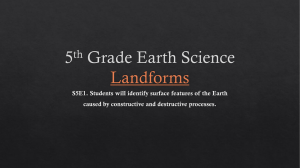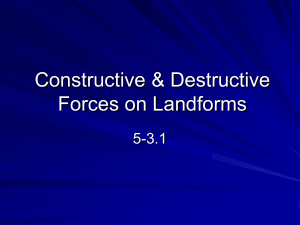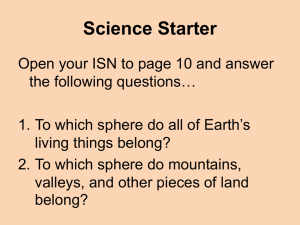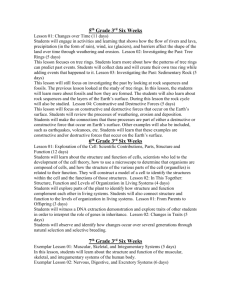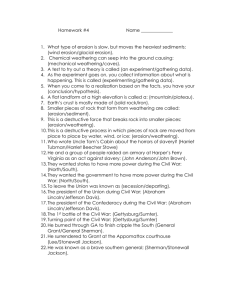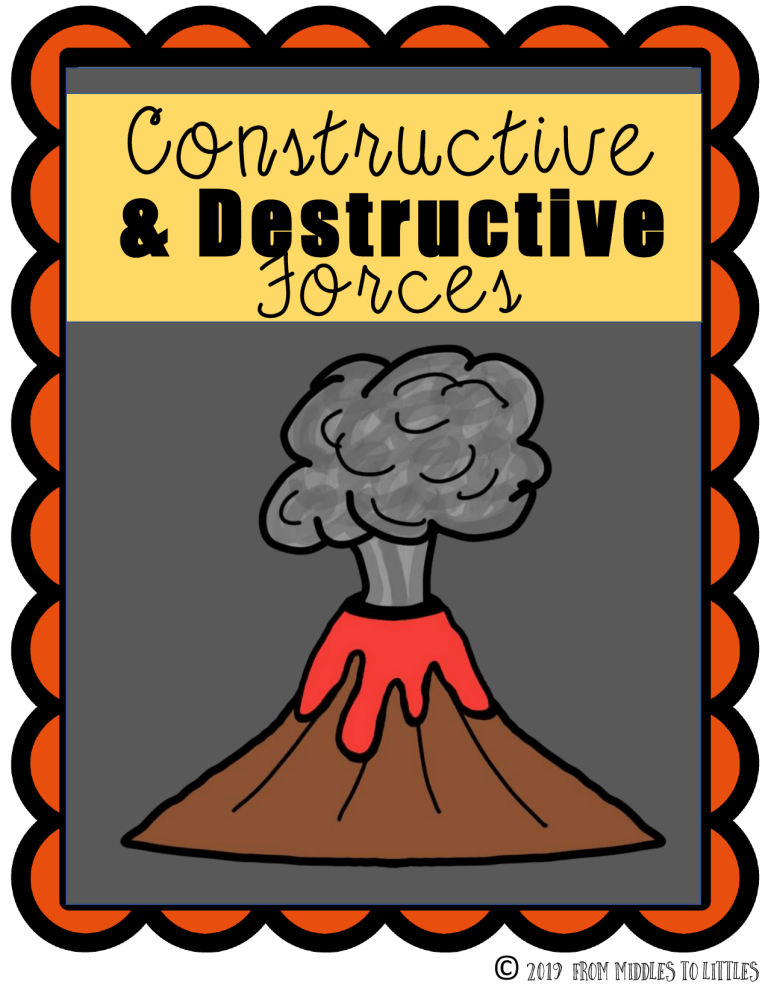
& Destructive © Name: _____________________ The surface of the Earth is constantly changing. Constructive forces build up the surface of the earth. Destructive forces wear the surface of the earth down. Constructive processes are constantly building up landforms like islands, sand dunes, mountains, or deltas. At the same time though, destructive forces like hurricanes, earthquakes, volcanoes, or even human actions are wearing the earth away. Constructive Forces Two major constructive forces are weathering and erosion. Weathering involves the wearing away of rock, and erosion describes the process of picking up and moving weathered rock to a new location. When wind or water are moving slowly, they may drop some of the pieces of rock they are carrying. This process of dropping of material by water, wind, or glaciers is deposition. The sediment dropped by deposition can create new landforms, like these: • Mountain – a large natural elevation of the earth’s surface. • Dune – a hill of sand deposited by wind, usually near the ocean. • Delta - a piece of land near the mouth of a river made up of sediment that has been deposited. • Beaches – created by thousands of years of sand washing ashore. • Moraine – a rocky ridge created by deposition when a glacier melts. © Destructive Forces Just as weathering and erosion can cause sediment and rock to build up (constructive), they can also cause land to wear away (destructive). Rivers can carry weathered rock over long distances for long periods, creating river valleys or deep canyons. As glaciers (huge sheets of ice that move slowly over land) move, they can also erode the soil and rock. Also, humans and animals can be destructive forces! Animals can wear away the earth by digging tunnels or burrows, which can cause the land to wash away more easily. Humans may clear land and trees for construction, which wears away the earth. In summary, erosion & weathering can be destructive processes. They can create river valleys or deep canyons. Animals and humans can also accelerate destructive processes. Volcanoes & Earthquakes An earthquake is the shaking of the ground caused by rock breaking and moving suddenly. A volcano is an opening in the earth’s surface that allows lava (hot, melted rock) and gases to escape. Earthquakes can cause wide cracks in the ground and destroy buildings, roads, and even cities. A volcanic eruption can blow the top off of a volcano, and the lava can also cause plants and animals to die. Although volcanoes and earthquakes are often thought of as destructive forces, they can actually be constructive, too. Over time, earthquakes can cause rocks to push up along faults and create entire mountain chains! Also, after volcanic eruptions, when lava piles up and cools, it can create a mountain. © Directions: Record definitions for each vocabulary word below. Refer back to pages 1 and 2 if you need help. • constructive force -_______________________ ______________________________________ • destructive force - ______________________ ______________________________________ • weathering - ___________________________ ______________________________________ • erosion - ______________________________ ______________________________________ • deposition - ____________________________ _____________________________________ • mountain - ____________________________ _____________________________________ © • dune - ________________________________ _____________________________________ • delta - ________________________________ _____________________________________ • beach- ________________________________ _____________________________________ • moraine - _____________________________ _____________________________________ • earthquake- ___________________________ _____________________________________ • volcano - _____________________________ _____________________________________ © Directions: Circle the best answer for each problem below. 1. Which landform is created by deposition from a glacier? a) dune c) volcano b) delta d) moraine 2. Deposition is a process that a) wears away rock b) moves rock to new places c) drops rock in new places d) wears away beaches 3. __________ is a hill of sand deposited by wind. a) moraine c) dune b) volcano d) tsunami 4. ___________ involve the wearing away of the earth. a) constructive forces b) destructive forces 5. How can earthquakes change the land? a) release ash into the air c) create cracks in the earth b) form sand dunes d) move weathered rock © 6. ____________ is the breaking down of rock at or near the earth’s surface. a) erosion c) deposition b) weathering d) moraines 7. What is the process where weathered rock is picked up and moved? a) erosion c) deposition b) weathering d) dunes 8. What is the shaking of the ground in which rock breaks and moves suddenly? a) earthquake c) landslide b) volcano d) hurricane 9. ______________ is a large sheet of ice that moves slowly over land. a) moraine c) glacier b) dune d) volcanic eruption 10. Which of the following is true? a) Volcanoes & earthquakes can be both constructive & destructive forces. b) Volcanoes & earthquakes are both destructive forces. ©
